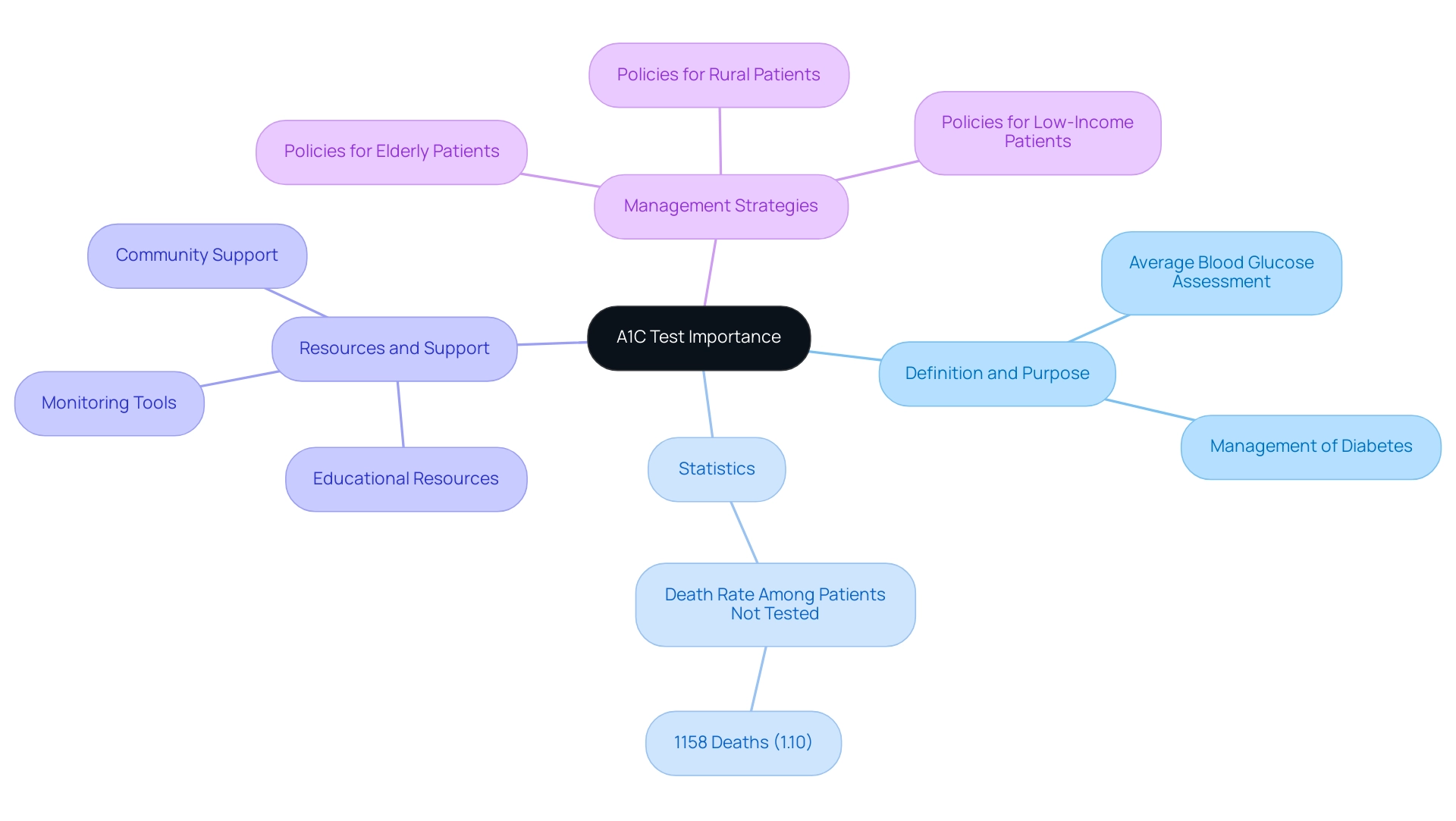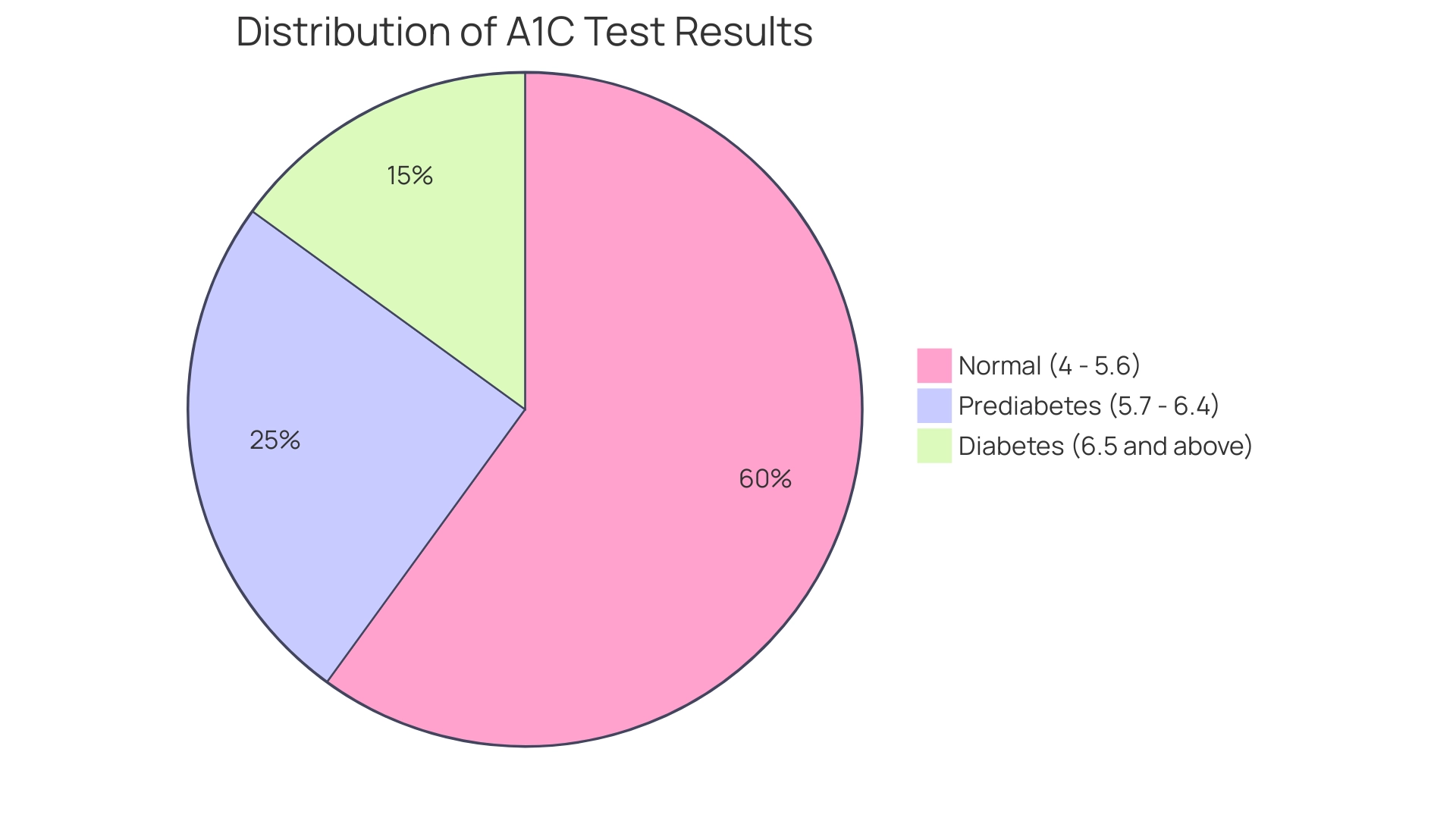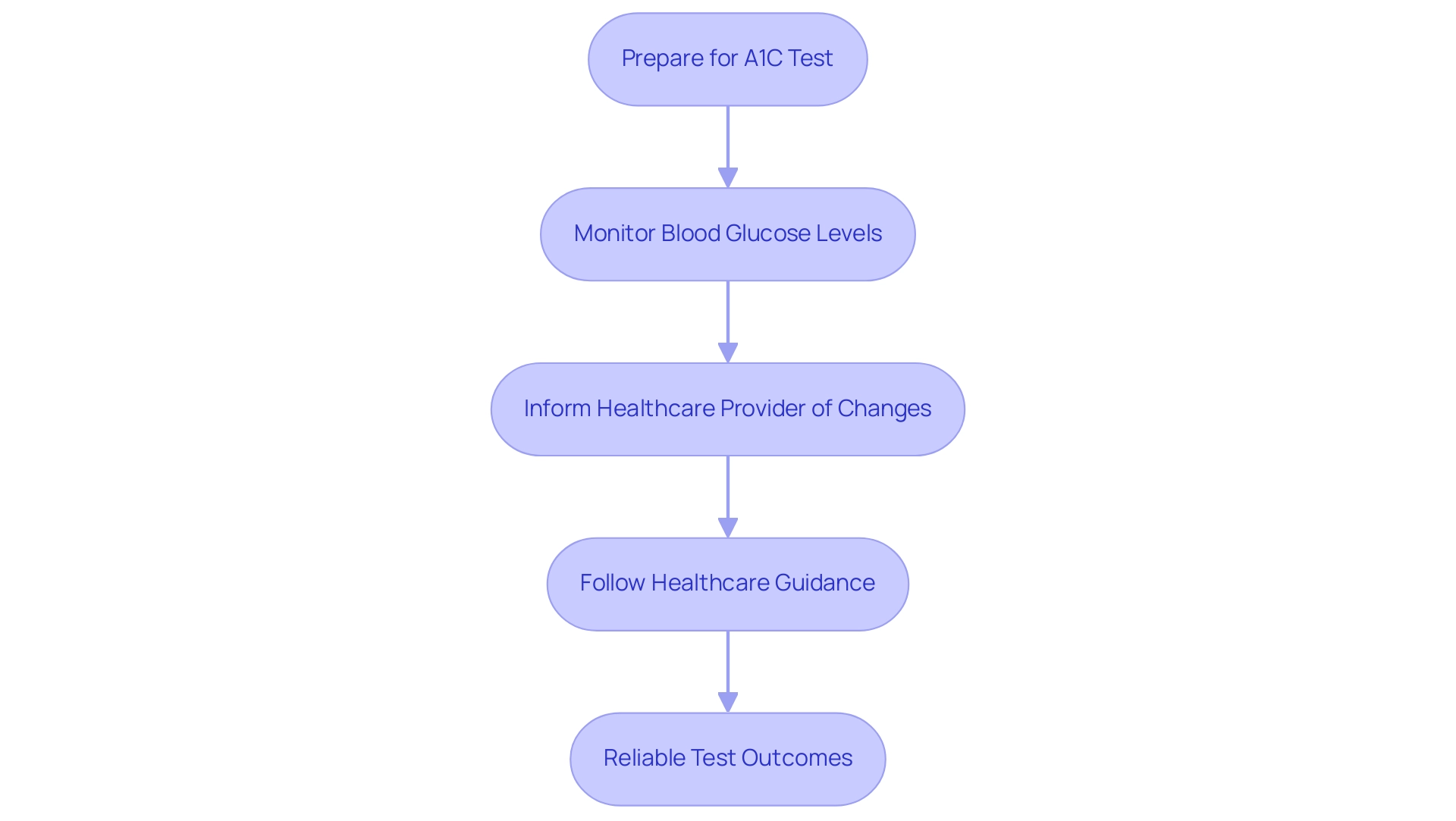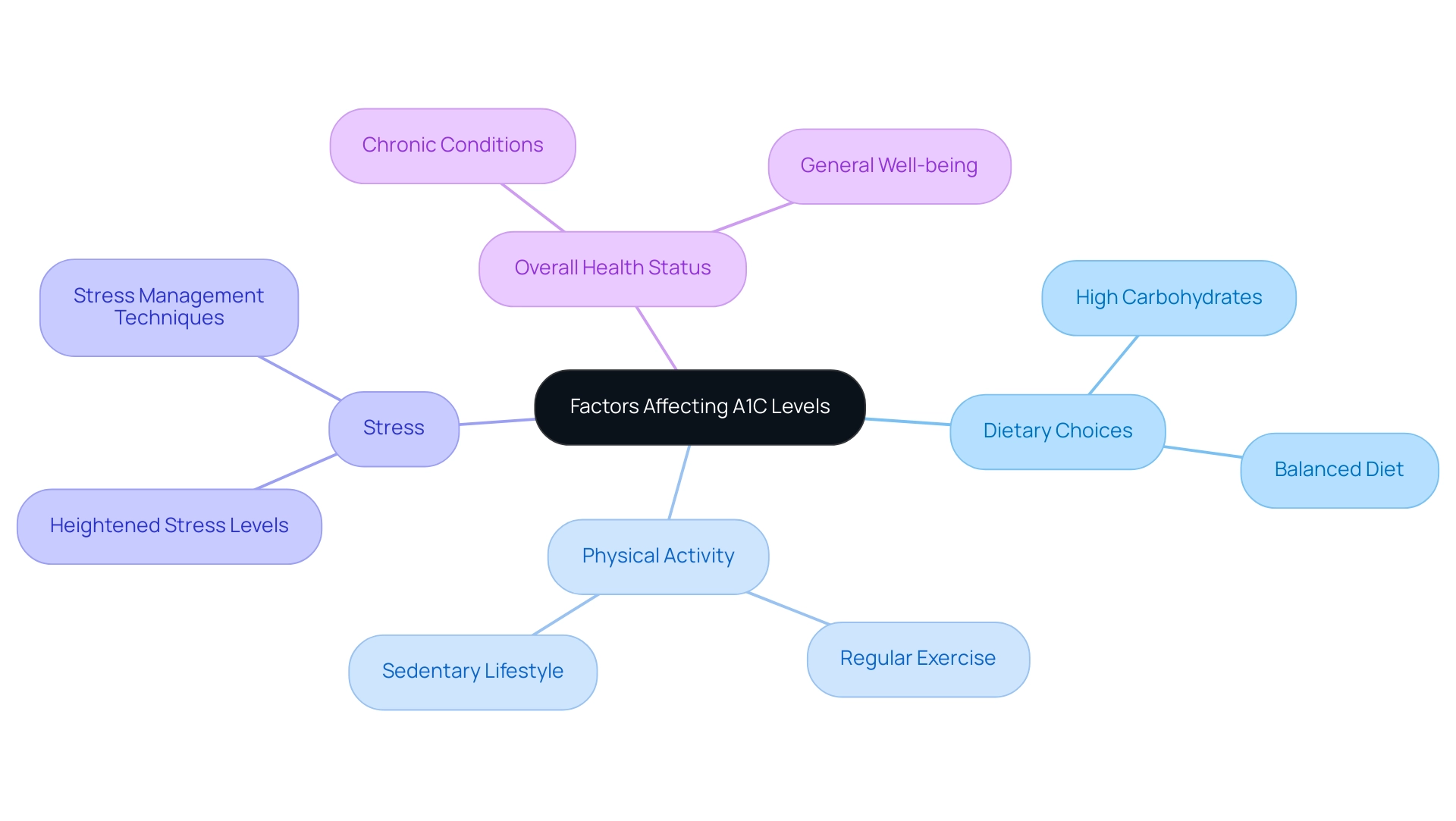Overview:
The A1C test is crucial for diabetes patients as it measures average blood glucose levels over the past two to three months, helping to assess diabetes management and risk of complications. The article emphasizes the importance of regular testing and personalized management strategies, supported by statistics showing the correlation between A1C levels and health outcomes, thereby underscoring the test's role in effective diabetes care.
Introduction
As the prevalence of diabetes continues to rise, understanding the A1C test becomes increasingly crucial for effective management of this chronic condition. The A1C test provides a snapshot of average blood glucose levels over a two to three-month period, serving as a vital tool for healthcare providers to gauge how well diabetes is being controlled.
Regular testing can significantly impact patient outcomes, as evidenced by alarming statistics regarding the health risks associated with infrequent monitoring. This article delves into the importance of the A1C test, how to interpret its results, and strategies for lowering A1C levels, all while highlighting the resources available through T2DSolutions—a new hub dedicated to empowering individuals navigating their diabetes journey.
What is the A1C Test and Why is it Important?
As T2DSolutions launches as a new resource hub for Type 2 and Type 3 diabetes education and community support, understanding the A1C test becomes increasingly vital for newly diagnosed patients. The A1C test, often called the hemoglobin A1C test, assesses the average blood glucose concentrations over the previous two to three months. This assessment offers healthcare providers with insights into how effectively blood sugar readings are being managed.
Alarmingly, the death rate among patients not receiving regular testing is 1158 (1.10%), underscoring the critical importance of regular A1C testing in preventing severe health outcomes. Generally, the test is conducted every three to six months, tailored to the individual's specific treatment plan. By evaluating A1C results from the a1c test diabetes, healthcare professionals can assess the risk of complications related to diabetes, informing necessary adjustments in both treatment and lifestyle.
With T2DSolutions, patients can access a variety of educational resources, tools for monitoring their A1C values, and community support, all aimed at empowering them in their health journey. We urge you to sign up for our updates to remain aware of new content and resources that can assist in your comprehension of A1C values and overall health care. Moreover, management policies must be created for elderly individuals, rural individuals, and low-income individuals who have low testing rates, highlighting the significance of customized management strategies.

Understanding A1C Results: What Do the Numbers Mean?
The a1c test diabetes results are essential indicators of long-term blood glucose control, reported as a percentage. The normal range for A1C values is between 4% and 5.6%. An A1C test diabetes measurement that falls between 5.7% and 6.4% indicates prediabetes, while a reading of 6.5% or higher confirms a diagnosis of diabetes.
For individuals already diagnosed with diabetes, the target A1C test diabetes value is typically set below 7%, although specific goals may vary based on individual circumstances such as age and coexisting health conditions. Notably, prediabetes awareness among Hispanic adults from 2017 to 2020 was only 20.9%, underscoring the need for effective A1C monitoring in this demographic. Elevated A1C readings from an a1c test diabetes are associated with an increased risk of complications, including cardiovascular disease, neuropathy, and renal impairment.
As stated by the American Diabetes Association Professional Practice Committee, 'There remains strong consensus that establishing a uniform approach to diagnosing GDM will benefit people with GDM, caregivers, and policymakers.' Understanding these results is crucial, as it enables patients and healthcare providers to work collaboratively on effective management strategies. These strategies often encompass:
- Dietary modifications
- Regular physical activity
- Tailored medication adjustments
Recent discoveries underscore the significance of regularly tracking the a1c test diabetes measures to reduce risks associated with the illness, further stressing the necessity for a proactive strategy in managing the condition. T2DSolutions, a new resource hub for Type 2 and Type 3 conditions education and community support, aims to assist individuals in understanding their health journey through the A1C test diabetes results. We invite you to subscribe for updates as we launch this platform dedicated to empowering patients with the knowledge they need.
Furthermore, trends in the occurrence of diagnosed conditions among adults show a notable decline in rates from 2008 to 2021, which highlights the significance of tracking the A1C test diabetes values and comprehending patterns over time.

How to Prepare for the A1C Test
Preparing for the A1C test diabetes does not require fasting or significant lifestyle changes. However, adherence to specific guidance from healthcare providers is crucial. Regular monitoring of blood glucose readings in the days leading up to the A1C test diabetes is recommended, as it offers significant context for interpreting the results.
Furthermore, patients should proactively inform their healthcare provider about any recent modifications in their medication regimen, dietary habits, or overall health status. These factors can significantly affect A1C values and are crucial for the A1C test diabetes, aiding in a more precise evaluation of blood sugar management. As part of T2DSolutions, we aim to provide comprehensive resources and support for newly diagnosed patients to better understand their A1C test diabetes levels.
Notably, research indicates that factors such as patient compliance rates and adherence to preparation guidelines can play a vital role in the reliability of test outcomes. For instance, if tests are independent, the sensitivity of the A1C test is 83% and specificity is 91%, which improve to 92% and 98% with two or more positive tests. As Roopa Naik states, 'Disclosure: Roopa Naik declares no relevant financial relationships with ineligible companies.'
This underscores the importance of unbiased information in understanding A1C testing. Additionally, the evolving definition of Gestational Diabetes Mellitus (GDM) highlights the implications of undiagnosed conditions, as hyperglycemia in pregnancy was estimated to affect approximately 21 million live births globally in 2021. For more information on diabetes management and preparation for the A1C test diabetes, we encourage you to explore the resources available at T2 Solutions.

What Affects A1C Levels?
A1C values, which should ideally be stable between 5.6% and 7.6% (corresponding to 38 and 60 mmol/mol), are influenced by a variety of factors, including:
- Dietary choices
- Physical activity
- Stress
- Overall health status
For instance, a diet high in carbohydrates can increase blood glucose amounts, which subsequently raises A1C readings. Conversely, regular physical activity is demonstrated to reduce blood sugar amounts and contribute to more favorable A1C results.
Stress control also plays a crucial role; heightened stress can lead to increased blood glucose levels, thereby impacting A1C. Additionally, certain medical conditions, such as anemia or specific hemoglobinopathies, can distort A1C readings, potentially leading to inaccurate assessments. Recent county-level studies reveal a concerning trend, with diagnosed cases of blood sugar disorders prevalence among U.S. adults ranging from 4.4% to 17.9% in different counties, indicating a growing public health challenge.
As emphasized by Qiuping Gu from the National Center for Health Statistics, 'Understanding these factors is crucial for effective control of diabetes-related conditions, such as the A1C test for diabetes management.' To assist patients in comprehending and overseeing their A1C readings, T2D Solutions provides an extensive resource center for education on the A1C test diabetes and glucose regulation for Type 2 and Type 3. We urge newly diagnosed individuals to visit T2D Solutions for educational resources and community assistance tailored to their specific needs, ensuring precise interpretations of A1C results and the formulation of suitable strategies.

How to Lower Your A1C Levels
As we launch T2DSolutions, a new resource hub dedicated to Type 2 and Type 3 diabetes education and community support, we emphasize the importance of effectively managing the A1C test diabetes values. T2DSolutions seeks to offer newly diagnosed individuals valuable resources, including dietary guidelines and tailored strategies for care. It is crucial to adopt a balanced diet that prioritizes whole grains, fruits, vegetables, and lean proteins, while minimizing processed foods and sugars.
Recent studies have indicated that such dietary modifications can lead to significant improvements in A1C values measured by the a1c test diabetes. For instance, a comprehensive study with 150 participants demonstrated varying responses to dietary interventions, underscoring the need for personalized approaches. Dr. Lydia A. Bazzano emphasized that intensive insulin control education programs, which include nutrition therapy, have proven to reduce A1C values, thereby underscoring the critical role of dietary strategies in the context of the A1C test for diabetes.
Regular physical activity is also essential; patients should aim for at least 150 minutes of moderate exercise each week to positively influence blood sugar control. Furthermore, following recommended medication schedules and consistently checking blood glucose readings are essential for effective A1C control. Stress reduction methods, such as yoga or meditation, are advised, as stress can adversely affect blood sugar rates.
Working closely with healthcare providers to create a tailored care strategy is vital for attaining and sustaining target A1C figures through the A1C test for diabetes, ensuring a holistic approach to condition oversight. T2DSolutions is here to support you on this journey with valuable resources and guidance, and we invite you to subscribe for updates as we continue to grow and provide more information.

When to Consult Your Healthcare Provider
Patients should proactively engage with their healthcare provider if their A1C test diabetes readings consistently exceed their target range or if they observe significant fluctuations in their blood sugar values. New symptoms, such as excessive thirst or frequent urination, may also indicate the need for medical consultation. Additionally, data suggests that lifestyle changes, which are essential for diabetes care, have been significantly low, with adherence rates varying from 4.3% to 2.5% among individuals with baseline A1C test diabetes readings of 9% or higher.
If these lifestyle changes do not yield improvements in A1C readings from the A1C test diabetes, or if there are concerns regarding medication side effects, it is essential to seek professional guidance. Consistent and transparent communication with healthcare providers is essential, as it ensures patients receive personalized support and modifications in their care plan. Historically, the monitoring nephropathy rate for Commercial HMO was 36.0% in 1999, highlighting the ongoing need for consistent monitoring of the A1C test diabetes levels.
According to Qiuping Gu from the National Center for Health Statistics, understanding the prevalence of both diagnosed and undiagnosed conditions related to blood sugar is crucial for effective management. A study focusing on the prevalence of undiagnosed blood sugar issues reveals that regular health screenings are particularly important for individuals with obesity, where the prevalence rose from 1.6% in underweight or normal weight individuals to 7.9% in those with obesity. Such findings demonstrate the critical role of healthcare consultations in effectively managing A1C levels through the A1C test diabetes and providing overall care for the condition.
Maintaining a consistent dialogue with healthcare professionals has been shown to enhance A1C control outcomes related to the A1C test diabetes, reinforcing the need for timely consultations. Additionally, T2DSolutions is launching as a comprehensive resource hub aimed at providing education and community support for individuals managing Type 2 and Type 3 conditions. Patients are encouraged to explore T2D Solutions for valuable resources that can assist in their diabetes management journey.

Conclusion
Understanding the A1C test is essential for effective diabetes management, particularly as its relevance grows in light of rising diabetes rates. This article has explored the significance of the A1C test, how to interpret its results, and the various factors that influence A1C levels. Regular testing is vital, as it provides healthcare professionals with the necessary insights to adjust treatment and lifestyle strategies, ultimately reducing the risk of severe health complications.
The interpretation of A1C results is crucial for patients and their healthcare teams. Recognizing the implications of different A1C levels—from normal to prediabetes and diabetes—enables tailored management plans that can significantly improve health outcomes. Moreover, factors such as diet, physical activity, and stress management play an important role in maintaining optimal A1C levels.
As T2DSolutions emerges as a key resource for individuals navigating diabetes, it offers a wealth of educational materials and community support designed to empower patients. By fostering a proactive approach to diabetes management, individuals can better understand their A1C results and implement effective strategies for lowering their levels. Engaging with healthcare providers and utilizing available resources are essential steps in achieving and maintaining target A1C levels, ultimately leading to improved health and quality of life.



